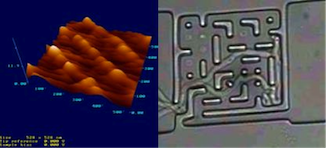Beyond Moore
"Beyond Moore": information storage and processing in biosystems.
A new class of diseases/medical conditions (eg. BSJ, alzheimer) have at their core the loss of information on molecular surfaces. There are also efforts to design biomimetic nanodevices, following the realisation that biomolecules are robust and effective biocomputation devices. At the cellular level, single cells are exquisite information processing devices. For instance, bacteria "emit" signalling chemical species indiscriminately and isotropically, which requires very efficient noise filtering and biocomputation in the receptor cells. Another method of transmission, specific to eukaryote organisms, relies on the actual and essentially noise-less transport of information by molecular motors between cells. Many questions remain regarding the coordination of movement of molecular motors inside eg. microorgnaisms (such as fungi). In both cases, ie. bacteria and molecular motors-based microorganisms (fungi) have extremely efficient methods for reception and filtering, and transmission, respectively, which are worth studying and emulating.
Projects studied under this "beyond moore" theme will be experimental and/or computational, for instance:
- Storage and resilience of information on the molecular surface of proteins
- Self-assembly of biomolecules (proteins and DNA) on pre- nano- structured surfaces, eg. DNA computation by tiling
- Algorithms used by micro-organisms for space, nutrient and cell search in confined spaces, etc.
These projects are particularly useful for students considering a further research career at the interface between engineering and medical/life sciences.
Figure 1 - Fungi explore mazes efficiently

Figure 2 - proteins self assemble on nano-structured surfaces
